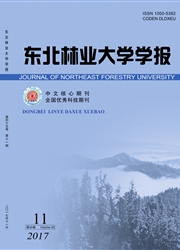

 中文摘要:
中文摘要:
为探究交联聚乙二醇二丙烯酸酯为载体的固定化漆酶的优势,采用单因素分析法,在不同条件下对固定化漆酶和游离漆酶的酶学性质进行了研究。结果表明:与游离漆酶相比,固定化漆酶与底物2,2-联氮-二(3-乙基-苯并噻唑-6-磺酸)二铵盐(ABTS)的亲和力下降,但稳定性明显提高,最适p H值也发生了变化。固定化漆酶的最适温度为60℃,比游离漆酶升高了5℃;固定化操作p H为3.5时,固定化漆酶的酶活力最高。固定化漆酶对2,4-二氯苯酚降解时间为24 h时,降解率达到了85%,酶活力保持80%以上,漆酶的使用效率和稳定性明显提高。
 英文摘要:
英文摘要:
The experiment was conducted to study the advantage of laccase immobilization with the carrier being cross-linked polyglycol diacrylate.The control variate method was used to investigate the activity between laccase immobilization and free laccase from different conditions.Comparing with free laccase,appetency between immobilized laccase and 2,2’-azinobis(3-ethylbenzthiazoline-6-sulfonate)(ABTS)descends,but the stability was improved and the optimum pH changed.The p H effect in the immobilization process was conducted simultaneously.The proper temperature of immobilized laccase was 60℃and 5℃higher than that of free laccase.The activity of immobilized laccase got the highest level when pH was 3.5.At last,the immobilized laccase was used in the biocatalysis of 2,4-dichloro-phenol.Results indicate that the degradation ratio achieved 85%in 24 h,and the kept activity was more than 80%with better use efficiency and stability of laccase.
 同期刊论文项目
同期刊论文项目
 同项目期刊论文
同项目期刊论文
 期刊信息
期刊信息
